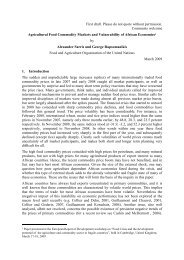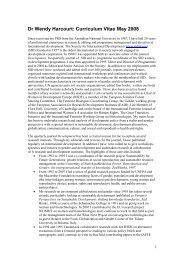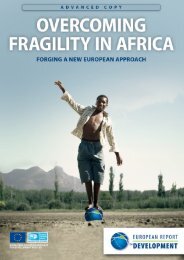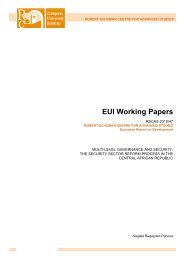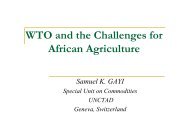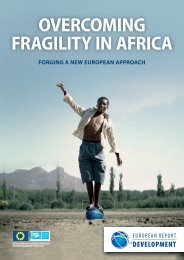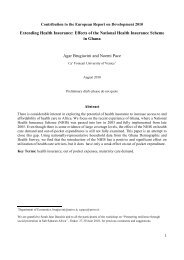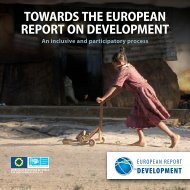desarrollo
desarrollo
desarrollo
Create successful ePaper yourself
Turn your PDF publications into a flip-book with our unique Google optimized e-Paper software.
Referencias<br />
Informe Europeo sobre el Desarrollo de 2009<br />
Studdard, K. 2004. “War Economies in a Regional Context:<br />
Overcoming the Challenges of Transformation.” IPA Policy<br />
Report. Nueva York: Academia Internacional de la Paz.<br />
Takeyh, R. y N. Gvosdev. 2002. “Do Terrorist Networks Need a<br />
Home” The Washington Quarterly 25 (3): 97-108.<br />
The Guardian. 2007. Hundreds of thousands of women raped<br />
for being on the wrong side. 12 de noviembre de 2007.<br />
Zoellick, R. B. 2008. “Fragile States: Securing Development.”<br />
Survival 50 (6): 67-84.<br />
REFERENCIAS DEL RECUADRO 1.1<br />
Clemens, M., S. Radelet y R. Bhavnani. 2004. Counting Chickens<br />
when they Hatch: The Short-term Effect of Aid on Growth,<br />
Documento de trabajo nº 44 del Centro para el Desarrollo Global,<br />
Washington DC: Centro para el Desarrollo Global.<br />
Feeny, S. y M. McGillivray. 2009. “Aid Allocation to Fragile States:<br />
Absorptive Capacity Constraints.” Journal of International<br />
Development 21 (5): 618-632.<br />
Gomanee, K., S. Girma, y O. Morrissey. 2005. “Aid and Growth in<br />
Sub-Saharan Africa: accounting for transmission mechanisms.”<br />
Journal of International Development 17 (8): 1055-1075.<br />
Lensink, R. y O. Morrissey. 2000. “Aid Instability as a Measure of<br />
Uncertainty and the Positive Impact of Aid on Growth.” Journal<br />
of Development Studies 36 (3): 31-49.<br />
McGillivray, M., S. Feeny, N. Hermes y R. Lensink. 2006.<br />
“Controversies over the Impact of Development Aid: It Works, It<br />
Doesn’t, It Might, but that Depends…” Journal of International<br />
Development 18 (7): 1031-1050.<br />
McGillivray, M. y S. Feeny. 2008. Aid and Growth in Fragile States.<br />
WIDER Discussion Paper No. 2008/03. Helsinki: Instituto Mundial<br />
de Investigaciones de Economía del Desarrollo.<br />
Morrissey, O. 2001. “Does Aid Increase Growth” Progress in<br />
Development Studies 1 (1): 37-50.<br />
REFERENCIAS DEL RECUADRO 1.2<br />
Baliamoune-Lutz, M. y M. McGillivray. 2008. State Fragility–<br />
Concept and Measurement. Documento de investigación<br />
nº 2008/44. Helsinki: Instituto Mundial de Investigaciones de<br />
Economía del Desarrollo.<br />
Bourguignon, F., A. Bénassy-Quéré, S. Dercon, A. Estache, J. W.<br />
Gunning, R. Kanbur, S. Klasen, S. Maxwell, J.-P. Platteau, and A.<br />
Spadaro. 2008. Millennium Development Goals at Midpoint:<br />
Where Do We Stand and Where Do We Need to Go Documento<br />
de referencia para el Informe Europeo sobre Desarrollo de 2009.<br />
Chhotray, V. y D. Hulme. 2009. “Contrasting Visions for Aid and<br />
Governance in the 21st Century: The White House Millennium<br />
Challenge Account and DFID’s Drivers of Change.” World<br />
Development 37 (1): 36-49.<br />
CAD-OCDE. 2006. Fragile States: Policy Commitment and<br />
Principles for Good International Engagement in Fragile States<br />
and Situations. Reunión de alto nivel del CAD, 5 y 6 de diciembre.<br />
CAD-OCDE. 2008. Concepts and Dilemmas of State Building<br />
in Fragile Situations–From Fragility to Resilience. París: OCDE.<br />
Collier, P. 2009. Wars, Guns, and Votes. Nueva York: HarperCollins<br />
Publishers.<br />
Consejo de la Unión Europea. 2007. Council Conclusions on<br />
an EU Response to Situations of Fragility. 2831ª Reunión del<br />
Consejo de Relaciones Exteriores, 19 y 20 de noviembre, Bruselas.<br />
Dollar, D. y V. Levin. 2006. “The Increasing Selectivity of Foreign<br />
Aid, 1984-2003.” World Development 34 (12): 2034-2046.<br />
Engberg-Pedersen, L., L. Andersen, y F. Stepputat. 2008. Fragile<br />
Situations–Current Debates and Central Dilemmas. Informe nº<br />
2008:9. Copenhague: Instituto Danés de Estudios Internacionales.<br />
Fielding, D. y G. Mavrotas. 2008. “Aid Volatility and Donor-<br />
Recipient Characteristics in ‘Difficult Partnership Countries’.”<br />
Economica 75: 481-494.<br />
Guillaumont, P. y S. Guillaumont Jeanneney. 2009. State<br />
Fragility and Economic Vulnerability: What Is Measured and<br />
Why Documento de referencia para el Informe Europeo sobre<br />
Desarrollo de 2009.<br />
Kaplan, S. 2008. Fixing Fragile States–A New Paradigm for<br />
Development. Westport: Praeger Security International.<br />
Levin, V. y D. Dollar. 2005. The Forgotten States: Aid Volumes<br />
and Volatility in Difficult Partnership Countries (1992-2002).<br />
Documento de síntesis elaborado para el DAC Learning and<br />
Advisory Process in Difficult Partnership. Oxford: Oxford Policy<br />
Management.<br />
REFERENCIAS DEL CAPÍTULO 2<br />
Adam, C. y S. O’Connell. 1999. “Aid, Taxation and Development<br />
in Sub-Saharan Africa.” Economics and Politics 11 (3): 225-54.<br />
Aksoy, M. A., Isik-Dikmelik, A., 2008, Are low food s pro-poor<br />
Net food buyers and sellers in low-income countries, Serie de<br />
documentos de trabajo nº 4642 sobre investigación de políticas<br />
del Banco Mundial, Washington DC: Banco Mundial.<br />
Banco Africano de Desarrollo. 2009. African Development<br />
Report 2008/2009. Túnez: Banco Africano de Desarrollo.<br />
Banco Mundial. Demographic and Health Surveys. Varios años<br />
y países.<br />
Banco Mundial. 2008a. World Development Indicators.<br />
Washington DC: Banco Mundial.<br />
Banco Mundial. 2008b. African Development Indicators 2007.<br />
Washington DC: Banco Mundial.<br />
Chauvet, L. y P. Collier. 2008. “What Are the Preconditions for<br />
Turnarounds in Failing States” Journal of Peace and Conflict<br />
Management 25 (4) 332-348.<br />
142



